IK’s newest iLoud speakers pack serious monitoring into an ultra‑portable format.
Paul White reviewed the original version of IK Multimedia’s iLoud Micro desktop active monitor very favourably back in 2016. The intervening decade has seen the monitor establish itself as one of the benchmarks when it comes to ultra‑compact portable monitoring, but its time is now over, because its replacement has arrived: the iLoud Micro Monitor Pro.
The iLoud Micro Pro and its predecessor share an almost identical aesthetic and at first I imagined that their injection‑moulded thermoplastic enclosures would be of the same dimensions, but I was wrong; the Micro Pro has grown a little, with its cabinet enclosing around three litres internal volume compared to the previous model’s two. This internal volume increase is significant in that it will help square the circle that comprises one of the fundamental constraints of all loudspeaker design: the trade‑off between low‑frequency bandwidth and maximum volume level.
Along with being dimensionally inflated, the iLoud Micro Pro differs from its predecessor in boasting increased amplifier power, by incorporating IK Multimedia’s ARC room correction system and X‑Monitor control app, and through the inclusion of an ARC measurement microphone. The increase in amplifier power apparently arises because, rather than working in a primary and secondary arrangement, where one monitor houses the amplification for both, the iLoud Micro Pro works as a conventional active system with amplification present in each monitor. The addition of X‑Monitor integration and ARC brings the iLoud Micro Pro up to the same feature level as IK Multimedia’s existing iLoud MTM and iLoud Precision monitors. ARC, and room correction generally, is potentially of significant value in a monitor such as the iLoud Micro Pro, which is likely to find itself pressed into service in all sorts of non‑optimal spaces and installations.
Other minor changes and improvements to the iLoud Micro Pro are the deletion of the previous 3.5mm TRS jack input and its replacement by a balanced XLR input, the inclusion of a slightly larger‑diameter tweeter, and, in acoustic specification terms, a marginally lower low‑frequency cutoff (50Hz against 55Hz) and a slightly higher maximum continuous sound pressure level (94dB against 92dB). The iLoud Micro Pro also incorporates an internal power supply rather than working from an external mains power adaptor.
Monitor Emulation
In addition to managing the ARC room‑correction process and general housekeeping functions (firmware updates, delays and standby setting), X‑Monitor offers speaker emulation that aims to impart the characteristics of a range of alternative monitors onto the iLoud Micro Pro. The monitors emulated aren’t fully identified in X‑Monitor, but the names drop some broad hints: I’d hazard a guess that White ’80s is the Yamaha NS10, and going by the image in the X‑Monitor promotional material, High‑End 3‑Way is an ATC SCM25A. X‑Monitor also provides emulations of generic hi‑fi speakers, TVs and mobile phones.
Of course X‑Monitor/ARC is not the only room‑correction product that provides such functionality, and I’ve expressed my doubts before about its genuine value. To my way of thinking, although it is fun and even perhaps useful at a very rudimentary level, speaker emulation has about as much chance of making a pair of iLoud Micro Pros sound truly like, say, an ATC SCM25A, as me donning a blonde wig will make my bass playing sound like Tina Weymouth. I say this because the subjective sound of any speaker is defined by so much more than simple frequency response. Speakers display a unique set of characteristics in terms of distortion profile, compression behaviour, time‑domain performance, delayed resonance signature and dispersion pattern that will define their sound as much as, if not more than, their axial frequency response. So it’s simply not possible to make one speaker genuinely sound like another through simple EQ.
Having said all that, the X‑Monitor/ARC speaker emulation is technically accomplished as far as it goes and I’m sure is intended to be useful rather than just a gimmick, even if it (and systems like it) can provide just a vague hint of the sound of an alternative monitor. Much better, though, to learn and understand through practice and experience how your monitoring translates to alternative playback systems and contexts.
Driving Force
The front panel of the iLoud Micro Pro carries a nominally three‑inch (75mm) bass/mid driver, a one‑inch (25mm) fabric‑dome tweeter and a generously flared reflex port exit. Said port curves upwards within the cabinet to a flared entrance high up behind the back of the tweeter. The generous length of the port is necessary to achieve the desired low tuning frequency; however, long ports often come with an undesirable side‑dish of organ‑pipe resonance, so it will be interesting to see if the iLoud Micro Pro designers have swerved that issue.
The diaphragm of the bass/mid driver is described as a “composite cellulose fibre” item, which I think translates into non‑marketing speak as “paper”. There is nothing remotely wrong with paper as a driver diaphragm material. The fact that it is still used so commonly is witness to the fact that it is generally so well suited to the role. Both iLoud Micro Pro drivers are protected by sturdy perforated metal grilles, which seems very sensible considering the highly portable nature of such compact monitoring, and the tweeter is mounted at the apex of a subtle elliptical waveguide moulded into the front panel. Speaking of moulding, one great advantage of constructing speaker cabinets from plastic is that edges can be generously softened, and that’s the case with the iLoud Micro Pro. Softened edges will help significantly to suppress the diffraction effects that would otherwise cause various frequency response discontinuities.
Under Pressure
The fundamental physics of loudspeakers defines a fixed relationship between the volume of air that must be moved by a diaphragm and the sound pressure level (SPL) at a certain frequency: as frequency falls and SPL rises, the volume of air required to move grows exponentially. The diaphragm moves air by pumping backwards and forwards, with the resulting SPL defined by the amplitude of the movement. In a reflex‑loaded speaker the port helps through the mass of air it contains, pumping similarly backwards and forwards — in phase with the driver at the port resonance frequency. Now, air volume is a multiple of diaphragm/port area and linear distance, so a diaphragm and port that are not much blessed with area, like those of the the iLoud Micro Pro, need to move a long, long way to generate reasonable SPL, and that’s potentially a problem, because both are limited by mechanical constraints (for example, the diaphragm can only move as far as its voice coil and suspension allow).
To illustrate all this, I built a simulation in some speaker modelling software of a reasonably high‑performance three‑inch OEM bass/mid driver in a three‑litre cabinet with a port tuned to 55Hz — a system that’s approximately representative of the iLoud Micro Pro. In my simulation, the diaphragm excursion (the distance the diaphragm has to move) reaches its effective mechanical linearity limit of ±5mm when generating around 93.5dB SPL (at 1m) at 70Hz. I wrote its “effective” limit because actually, diaphragm excursion rockets further upwards at frequencies below the port resonance; however, that can be fixed in the simulation by adding a high‑pass filter at around 35Hz, and it’s likely that the iLoud Micro Pro incorporates something similar. The filter protects the bass driver from over‑excursion and the amplifier from wasting precious power ineffectually pumping the diaphragm backwards and forwards (“ineffectually” because, in common with all reflex‑loaded speakers, the iLoud Micro Pro is able to generate only minimal useful output below the port resonance frequency).
But it’s not just the driver that has a linearity limit. The reflex port has one also, and my simulation shows that the airflow velocity through the port when the system is generating 93.5dB is well into the non‑linear, turbulent‑flow region and likely to be noisy. Now, obviously, without knowing all the electro‑acoustic details of the iLoud Micro Pro, I can’t be certain that my simulation is perfectly representative, but I’d bet the house on it being not far off. I say that because my simulated maximum sound pressure level of 93.5dB, combined with a low‑frequency cutoff of 55Hz (‑3dB), is within a gnat’s whisker of the iLoud Micro Pro published specs. Its “continuous max SPL” specification is 94dB and its low‑frequency cutoff is 50Hz. However, along with a continuous SPL specification, IK Multimedia publish a “peak SPL” spec for the iLoud Micro Pro of an eyebrow‑raising 109dB. I’m somewhat at a loss to understand how such a level is realistically possible from the iLoud Micro Pro, and I think 109dB needs to be accompanied by a large pinch of salt.
There’s an added complication too, because the real‑world maximum SPL of a speaker that is likely to be massaged by significant room compensation EQ, such as the iLoud Micro Pro, is almost impossible to predict. For example, in my installation, the ARC room compensation introduced a significant EQ dip between 70Hz and 90Hz, which will benefit potential maximum SPL. But ARC also introduced around 3dB of gain at around 200Hz, and that will not only work the bass/mid driver harder, it will also ask questions of the iLoud Micro Pro’s amplification headroom, because 3dB of gain requires double the amplifier power.
All this analysis and explanation is to show just how critical these electro‑acoustic calculations become when monitors are miniaturised. The compromise reached by the engineers behind the iLoud Micro Pro is, I think, pretty well judged in its ability to offer worthwhile low‑frequency bandwidth combined with more than usable maximum SPL. It’s not, as described in the iLoud Micro Pro literature, “physics‑defying”, but it’s quite an achievement, especially at the price.
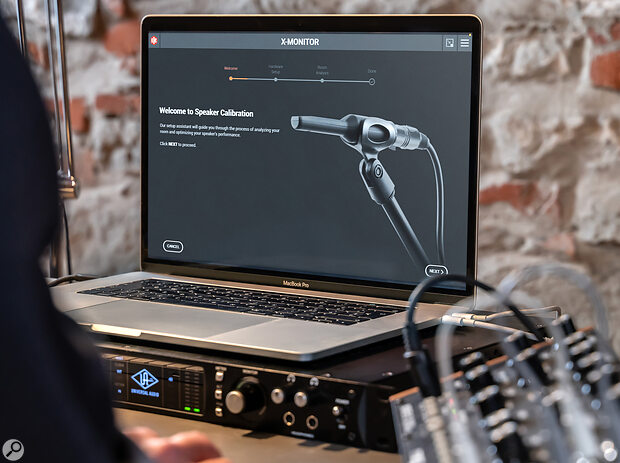 The iLoud Micro Pro ships with an ARC measurement microphone, for room correction using the X‑Monitor app. X‑Monitor also lets you emulate a selection of studio and domestic playback systems.
The iLoud Micro Pro ships with an ARC measurement microphone, for room correction using the X‑Monitor app. X‑Monitor also lets you emulate a selection of studio and domestic playback systems.
Setting Up
Instead of installing the iLoud Micro Pros at the acoustically treated ‘business end’ of the studio, I decided to set them up at a secondary workstation at the other end of the room. The intention here was to use the monitors in the kind of a less‑than‑ideal environment that they might well find themselves in the real world, while also giving the ARC system a thorough workout.
The ARC process, managed through the X‑Monitor app, is pretty quick and straightforward. With the monitors connected to the computer via USB, X‑Monitor automatically identifies that the monitors are present, and when you’ve confirmed that the correct monitor is in the appropriate location, hitting the X‑Monitor Calibration button begins the room compensation process. X‑Monitor presents a series of screens which guide you through the process of connecting the supplied ARC measuring microphone and taking the measurements. ARC requires sine‑sweep measurements taken from four locations around the listening position for each monitor, and when those are complete it calculates the EQ required to flatten the frequency response of the monitor at the listening position.
ARC optimises each monitor individually, and this has both up sides and potential down sides. The main up side is that it’s easy to scale up a monitoring system to include multiple monitors — in fact iLoud Micro Pro packages up to 7.x.4 are available. I’ve substituted an “x” for the usual .1 LFE because, at present, there’s no compatible IK Multimedia subwoofer, and X‑Monitor offers no bass management facilities. A possible down side of ARC treating monitors individually is that it might apply radically different EQ to each monitor of a stereo pair, and that will have the potential to degrade stereo imaging. Neumann’s MA 1 room‑compensation system, for example, treats stereo monitors as composite systems for this very reason. ARC is easy to use and although relatively limited in its implementation with the iLoud Micro Pro, it works well. It is clearly less technically sophisticated and capable than, for example, the Trinnov system, but then it is also very significantly less expensive.
Measurements
I took one iLoud Micro Pro to my usual empty church space and made a few measurements. Diagram 1 shows the iLoud Micro Pro’s axial frequency response, and it demonstrates a reasonably flat characteristic with no obviously issues, although the tweeter level looks a little exaggerated. However, there are two curves overlaid on Diagram 1, one taken at 90dB SPL and one taken at 80dB SPL, and that’s because I quite quickly discovered when taking data that the iLoud Micro Pro incorporates a limiter function intended to protect its small bass/mid driver from overload. This is really no great surprise (numerous much larger active monitors incorporate limiters) because the laws of physics are inalienable, and despite the aspirations of marketing departments, ultra‑compact, inexpensive monitors have their limits. So, the red curves of Diagram 1 shows that the iLoud Micro Pro begins to turn its bass/mid driver down once the SPL gets to about 90dB (it will let louder short‑term peaks pass unmolested). The remainder of my iLoud Micro Pro data was captured at 80dB. Lastly on Diagram 1, phase response data is inherent to the capture of a frequency response and although I’ve not complicated Diagram 1 by including it, I can confirm that, as claimed in its promotional material, the iLoud Micro Pro has a generally linear phase characteristic from around 300Hz upwards.
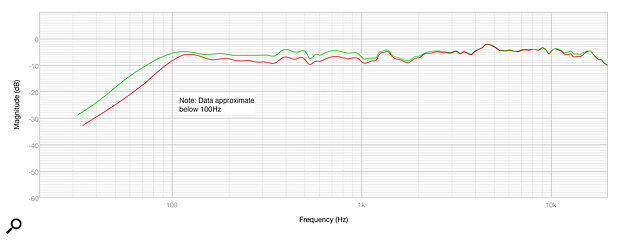 Diagram 1: The on‑axis frequency response of the iLoud Micro Pro, measured at 80 and 90 dB SPL at 1m (green and red curves, respectively). The measurements have been normalised to allow for direct comparison.
Diagram 1: The on‑axis frequency response of the iLoud Micro Pro, measured at 80 and 90 dB SPL at 1m (green and red curves, respectively). The measurements have been normalised to allow for direct comparison.
Diagram 2 again shows the axial frequency response (at 80dB), but this time with the second‑ and third‑harmonic distortion displayed. In the context of its very small dimensions and low price, the distortion performance of the iLoud Micro Pro is perfectly reasonable. Distortion, especially with bass/mid drivers, is very much a function of diaphragm excursion, and with so little diaphragm area available, more excursion is required. Through the critical mid band, distortion runs at around ‑40dB to ‑50dB, or between 1% and 0.3%. This is pretty typical of inexpensive compact monitors.
 Diagram 2: The on‑axis response, and distortion products at 80dB SPL (at 1m). Second and third harmonics are shown in green and blue, respectively.
Diagram 2: The on‑axis response, and distortion products at 80dB SPL (at 1m). Second and third harmonics are shown in green and blue, respectively.
In Diagram 3 I checked the function and effect of the rear‑panel EQ switches, The diagram shows the axial response overlaid with high‑frequency and low‑frequency attenuation and boost. The desk EQ option is also overlaid. The rear‑panel EQ is perhaps somewhat academic thanks to the availability of the X‑Monitor app and ARC, but it’s useful to see what it does. It works pretty much as expected although the LF and HF EQs operate over relatively restricted bandwidths. They are quite subtle.
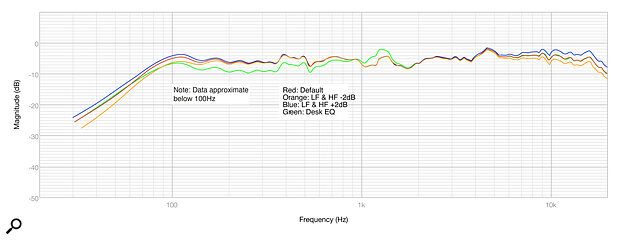 Diagram 3: Comparing the speaker’s response in its default flat mode (red trace), with +2dB on the HF and LF bands (blue), with LF and HF set to ‑2dB (orange), and with the desk EQ option engaged (green).
Diagram 3: Comparing the speaker’s response in its default flat mode (red trace), with +2dB on the HF and LF bands (blue), with LF and HF set to ‑2dB (orange), and with the desk EQ option engaged (green).
I wrote earlier about the experience of using ARC to compensate for my studio acoustics, and as the ARC parameters remain with the monitor rather being stored within the X‑Monitor app, it is possible to engage and disengage them from the iLoud Micro Pro’s rear‑panel Cal button. So, Diagram 4 shows the default axial response overlaid with the result of my ARC room compensation. The dip aimed at suppressing the primary low‑frequency mode in the room is the most significant feature.
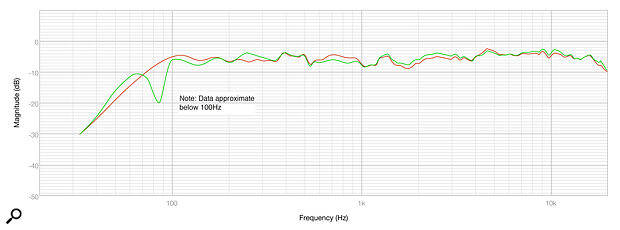 Diagram 4: Before and after ARC processing (red and green traces, respectively).
Diagram 4: Before and after ARC processing (red and green traces, respectively).
Finally, I mentioned the risk of organ‑pipe resonance in long reflex ports, and Diagram 5 shows the result of placing the measurement mic right in the port mouth. The desired port resonance at between 50Hz and 60Hz is obvious, and its decay thereafter is very clean. The feature around 1kHz probably is a port organ‑pipe effect, but because the port mouth is so close to the bass/mid driver on the iLoud Micro Pro it’s actually quite difficult to disentangle their outputs. A bit of further geeky data processing I carried out suggests quite strongly that the 1kHz feature comes from the port, but it is somewhat academic because its level is significantly below that of the bass/mid driver. I’d give the port a clean bill of health for this reason. It would be interesting to know how the iLoud Micro Pro designers have suppressed the organ‑pipe resonance, but disassembling review samples to look inside is generally frowned upon.
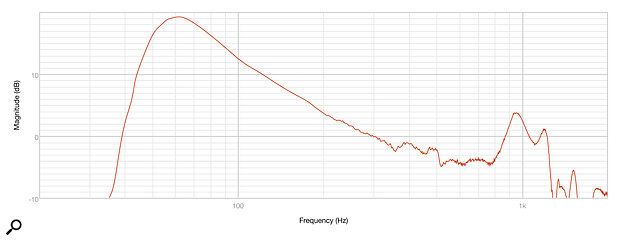 Diagram 5: A close‑mic measurement of the port output.
Diagram 5: A close‑mic measurement of the port output.
Listening In
Measurements reveal that the iLoud Micro Pro is a very competently engineered monitor. It has a generally flat frequency response, linear phase response, acceptable distortion and no sign of any unexpected and significant flaws. It is a very small monitor, though, so volume levels that stray into loud territory are challenging. But what does it sound like? I spent some time with the iLoud Micro Pro in both its default mode and then ARC optimised for my studio installation. In default mode I found the overall balance of the iLoud Micro Pro slightly bright, so very quickly went for the tweeter cut option. That helped, but I then felt that the iLoud Micro Pro lost a little of its clarity. Bass is surprisingly extended for such a compact monitor, but port noise could become audible with bass‑heavy material at volume levels not far beyond gentle. Between bass and high frequencies, however, lives the all important midrange, and the iLoud Micro Pro does a pretty good job of reproducing it. The iLoud Micro Pro’s midrange character doesn’t have the showstopping, see‑through clarity and detail of the best nearfield monitors, but it’s revealing enough for mix work and is tonally neutral. Stereo imaging is strong, with good focus and satisfying depth. Reverb tails are nicely detailed and firmly located in space.
ARC mode did bring some significant benefits in terms of even tighter imaging and a better sense of tonal accuracy.
In ARC optimised mode I’d hoped that the low‑frequency attenuation applied to suppress the room mode would also benefit the low‑frequency power handling and allow the iLoud Micro Pro to play louder without port noise. That wasn’t initially the case, because the default ARC equalisation, as well as attenuating between 70Hz and 90Hz, also added some gain at lower frequencies. However, using the X‑Monitor EQ facilities to add a little low‑frequency attenuation worked wonders to restrict the iLoud Micro Pro’s over‑enthusiastic ambitions to perform like a somewhat bigger monitor, and allowed it to play a little louder. ARC optimisation did bring some significant benefits in terms of even tighter imaging and a better sense of tonal accuracy. It also brought a little more detail to the midrange and simultaneously fixed my slight concerns around the inherent high‑frequency balance.
The iLoud Micro Pro is a very small monitor, and despite the claims of 109dB, its genuinely high level of performance is only really available at modest volume level — the kind of levels suited to very nearfield desktop use. Push the iLoud Micro Pro too hard and its performance quite quickly becomes a little loose and slightly messy. But in the end, the combination of ARC optimisation with a little more targeted X‑Monitor EQ tweaking resulted in the iLoud Micro Pro working very well in its intended role and sounding really very good indeed. So good I stopped listening analytically and started just enjoying the music.
Connections
 On the rear panel we find a gain control, balanced XLR and unbalanced RCA phono input sockets, a mains input socket and power switch, a USB‑C socket for connection of the supplied measurement microphone, and a matrix of push buttons that offer some broad‑brush tonal adjustment, and which can also used to put the iLoud Micro Pro into ARC equalised mode.
On the rear panel we find a gain control, balanced XLR and unbalanced RCA phono input sockets, a mains input socket and power switch, a USB‑C socket for connection of the supplied measurement microphone, and a matrix of push buttons that offer some broad‑brush tonal adjustment, and which can also used to put the iLoud Micro Pro into ARC equalised mode.
Alternatives
Unusual as it is, the iLoud Micro Pro doesn’t have the field entirely to itself. If you feel the urge to build your own monitors, there’s the AudioSmile LBM, but if not, the AIAIAI Unit 4 and ADAM DV3 are worth investigating, as is the more conventional Genelec 8010A.
Pros
- Tiny dimensions.
- Well designed and engineered.
- Highly capable monitoring performance.
- ARC and X‑Monitor integration is effective and works well.
Cons
- Struggles with low bass and high volumes.
Summary
The iLoud Micro Pro continues the theme of its predecessor but brings both significant performance improvements and very effectively integrates ARC and X‑Monitor. It absolutely hits the target for ultra‑compact and portable monitoring.
Information
£599.99 per pair. Individual speakers £299.99 each; 11‑speaker immersive bundle £2999.99. Prices include VAT.
$599.99 per pair. Individual speakers $299.99 each; 11‑speaker immersive bundle $2999.99. Prices exclude tax.
When you purchase via links on our site, SOS may earn an affiliate commission. More info...
When you purchase via links on our site, SOS may earn an affiliate commission. More info...



